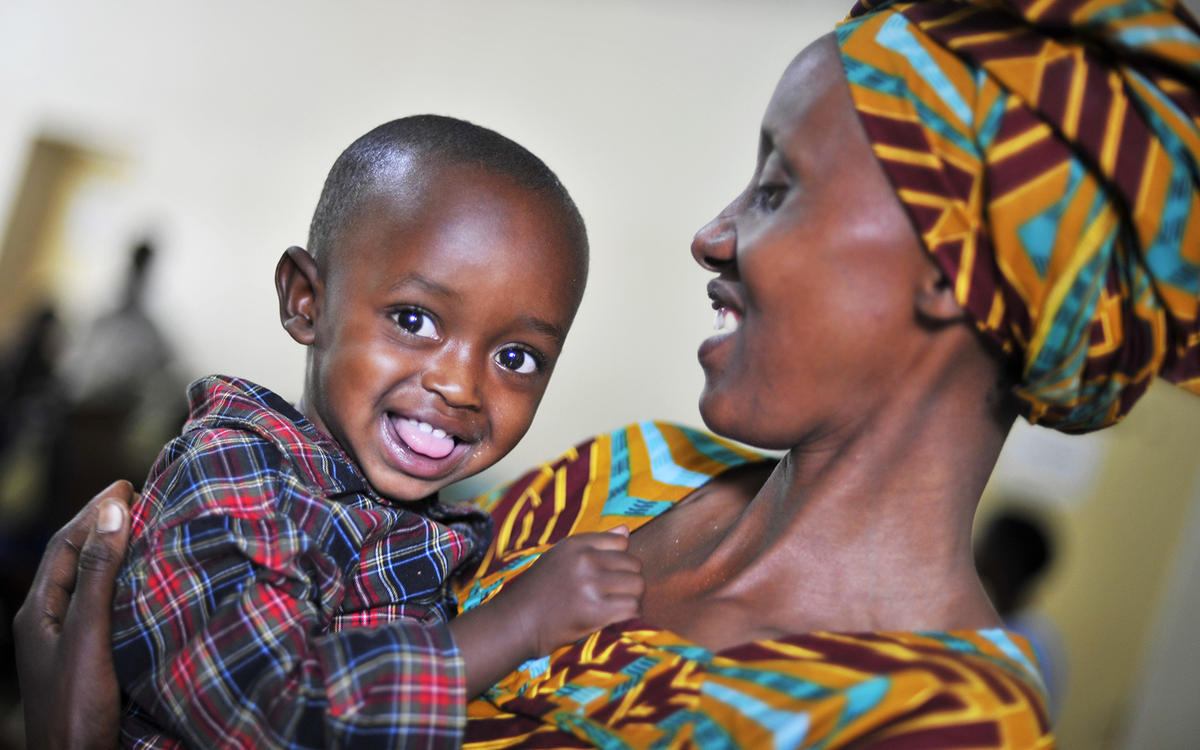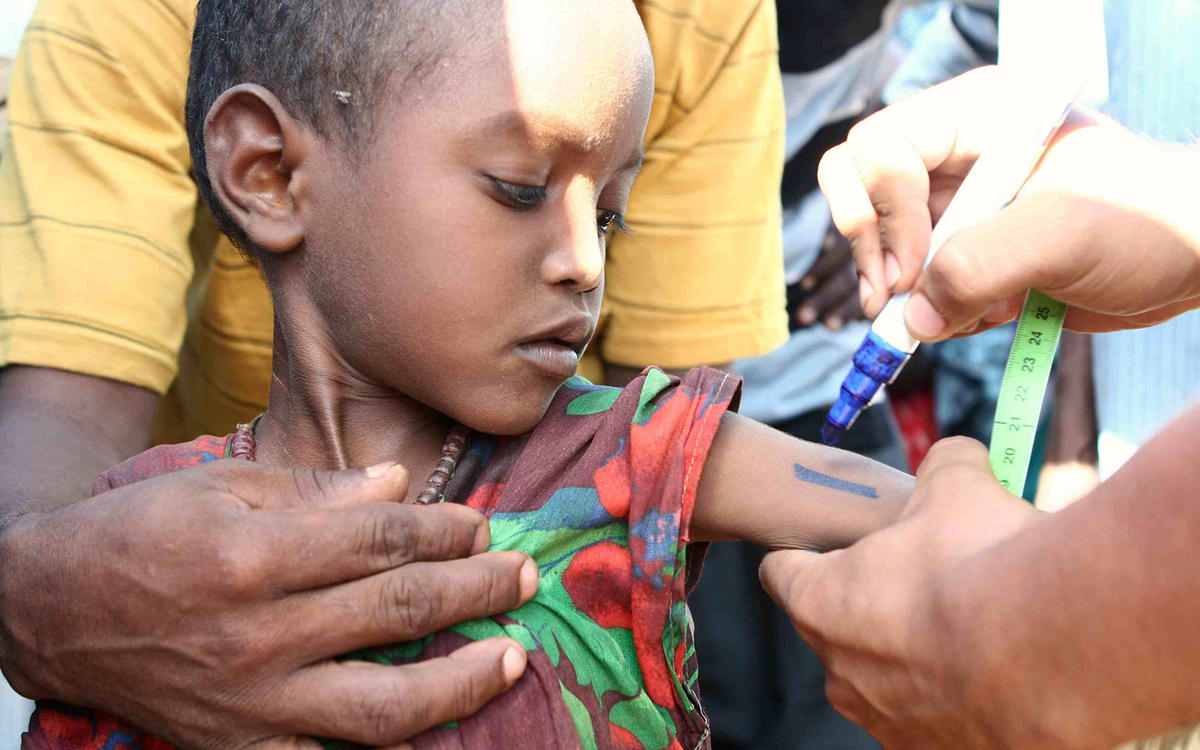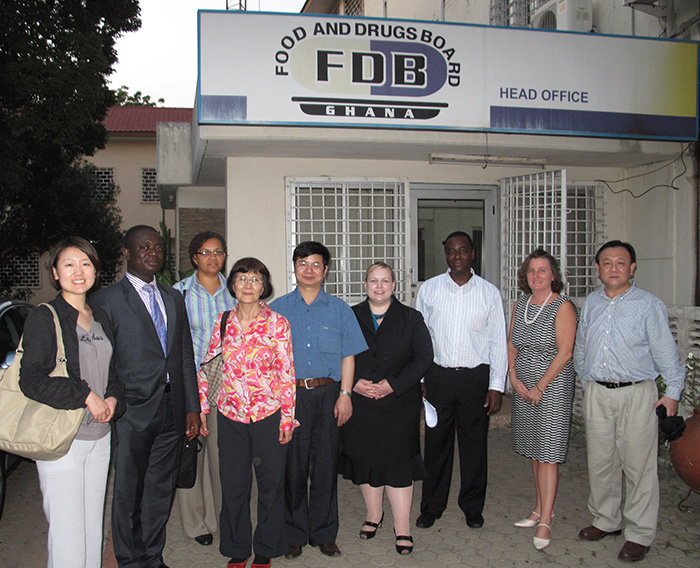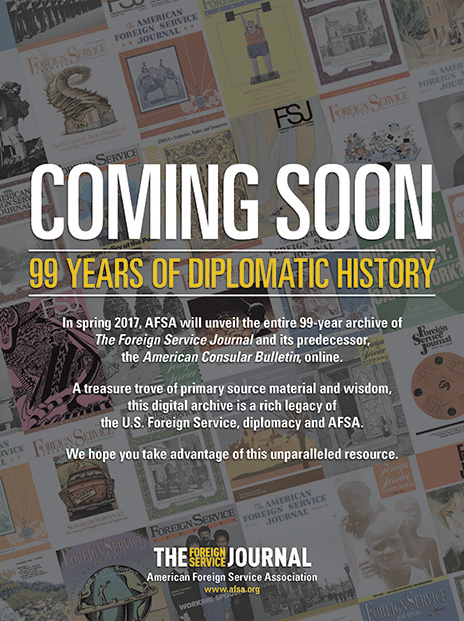USAID FSOs Reflect on Global Health Diplomacy
Health-focused development programs have been a core activity at the U.S. Agency for International Development since the agency’s establishment in 1961.
BY MARIA B. SPADACINI

Charlotte Niwemusa and her son, Justin, wait to see a doctor at Manyange Health Center in March. In Rwanda, USAID works with partners to improve information systems, supply chain management and training of health workers.
USAID / Riccardo Gangale
One vital measure of a country’s strength is the health of its population. After all, healthy people perform better in school, are able to work and can contribute to economic growth and national stability. Thus, money spent on health care offers a good return on investment. According to “Global Health 2035: A World Converging within a Generation,” a study published in 2013 by The Lancet, every dollar spent on health care results in $9 to $20 worth of economic and social benefits.
Money spent on national health care objectives trickles down, affecting both individuals and the communities in which they live. When Americans are deployed to some of the poorest countries in the world for the sole purpose of saving lives and reducing suffering, long-lasting partnerships are forged through trust, appreciation and mutual respect.
“Global health is an excellent vehicle for representing the values of the U.S. and reaching a broad section of a country, including those who would not normally interact with diplomats,” says Jennifer Adams, acting assistant administrator for global health at USAID, who has been a Foreign Service officer for more than 20 years and has served in Brazil, Central Asia, Senegal and China.
Addressing a Basic Human Need
In countries that receive USAID assistance, global health programs address the most basic needs and concerns of individual citizens. “Through global health, we are able to connect on many issues that are important both to the population and to the leadership of the country. Connecting on this level gives us the opportunity to engage an entire system in one of the most critical areas for any government,” explains Adams.
“Development programs that focus on improving health garner incredible good will from the people in the countries where we serve,” adds Kathryn Panther, who joined the Foreign Service on Sept. 10, 2001, and retired this year.
“In health we are able to show that our programs work because we can measure success more easily than in other sectors, and many of our interventions are data-driven.”
—FSO Richard Green
“As a Foreign Service health officer working in developing countries,” she says, “I experienced firsthand the profound gratitude from mothers whose children were saved thanks to our health and nutrition programs. I saw joy and hope on the faces of those afflicted by AIDS, knowing that life-saving medicines provided by the American people had commuted their death sentences. For many people and health-care providers who benefited from U.S. government-funded medicines and services, we are the face of the United States of America, and they have great respect for us as a people and as a country.”
While gratitude is important, it is only the tip of the iceberg. What ultimately matters is effective programming and lasting impact—which is why USAID employs data-driven decision-making to sharpen its programs and measure success. USAID’s annual review of Mission Health Implementation Plans, strategic plans for use of global health funds, is a key element of the agency’s analysis. This review process ensures that programs, budgets and implementing mechanisms are aligned with U.S. government global health priorities and support state-of-the-art programs grounded in evidence.
Our analysis shows that since 2008, USAID’s efforts to end preventable child and maternal deaths have helped save the lives of 4.6 million children and 200,000 women in priority countries. All-cause mortality rates among children under 5 have declined significantly in 16 out of 19 African countries covered under the President’s Malaria Initiative, with declines ranging from 18 percent to 67 percent. Through the President’s Emergency Plan for AIDS Relief, or PEPFAR, USAID works to link thousands of people to proper care and treatment and has increased the number of HIV-positive people on life-saving antiretroviral treatments to 11.5 million. In Fiscal Year 2015 alone, USAID tested 24.9 million people, treating close to four million people and ensuring that more than 410,000 pregnant women received antiretroviral medications to prevent mother-to-child transmission of HIV.
Kerry Pelzman, a Senior Foreign Service officer who is the current director of USAID/Southern Africa’s bilateral health office in Pretoria, says that the human face of health assistance transcends bilateral tensions and brings out the best in us all. She argues that “the lifesaving nature of many health interventions, often supported through foreign assistance, can generate positive opinions about America and Americans.” There doesn’t seem to be as much scope for ulterior motives in the health sector, she says, with potentially less room for backlash and criticism.

A child in the Dolo Ado refugee camp, on the border between Ethiopia and Somalia, is measured to determine if he is malnourished. Addressing malnutrition from an early age can prevent stunting and ensure healthy growth. USAID supports programs that integrate nutrition interventions across sectors.
Beatrice M. Spadacini
A Long-Term Commitment to Saving and Improving Lives
Global health programs have been a USAID core activity since President John F. Kennedy established the agency in November 1961. USAID was created in the aftermath of two world wars with the intent of building a more stable world through sustained and well-targeted bilateral interventions. It was an act of leadership in an increasingly interdependent world.
Working to save lives in some of the poorest countries around the world has created strong relationships among a variety of stakeholders, including national health authorities and local communities. It has also given the agency a thorough understanding of health needs and gaps in a variety of contexts. After all, many USAID Foreign Service health officers spend their careers overseas working shoulder to shoulder with their local counterparts. This translates into a level of trust that manifests itself in long-lasting partnerships.
“Unlike other donors, USAID is very local in its approach, and this is one of our strengths,” says Adams. “We have maintained a long-term commitment in about 80 missions around the world. We still rely on local hires, some of whom have worked for USAID for more than 30 years. We therefore have history, institutional memory and capacity to build on that is unique to us.”
Furthermore, U.S. leadership in global health often sets the tone, pushing other countries to take health issues seriously and to establish commitments on a global level. Pelzman was working in Russia when former Secretary of State Colin Powell visited and referred to HIV as a “virus of mass destruction.” It was in part as a result of his advocacy, she says, that the government of Russia submitted an application to the Global Fund to Fight HIV, TB and Malaria, a first for that country.
U.S. leadership in global health often sets the tone, pushing other countries to take health issues seriously and to establish commitments on a global level.
Pelzman also points to USAID’s success in Child Survival: Call to Action, a global effort launched in June 2012 to reduce maternal and child mortality. USAID’s groundwork in India led that government to become a key founding member of this initiative, helping to drive the country’s own maternal health agenda. Lastly, Pelzman lauds the impact of significant and long-term investment by the U.S. government in PEPFAR in South Africa and the partnership that has resulted from this resource commitment.
“In all three of these cases,” says Pelzman, “U.S. government funds have by no means been the lion’s share of health budgets. But our technical expertise, the global best practices we brought to bear, the groundbreaking pilots and evidence we helped to develop—often advanced even further by our remarkable local staff and their ability to establish effective relationships with senior government officials—all had impacts far beyond the dollar amounts.”
Beyond the Health Sector
Global health programs that address national priorities such as improving mother and child health or combating infectious diseases like HIV/AIDS or malaria unfold on multiple levels (national, state or region, and district) and require building relationships with a variety of stakeholders. These types of programs can be vehicles for strengthening other areas that are important to diplomacy, including good governance, decentralization, private sector engagement, domestic resource mobilization, community involvement and civil society participation.
Adams experienced this synergy when she served in Senegal. At that time, the government was decentralizing control, pushing resources to provincial and district levels. “Through our health programs, USAID worked closely on the rollout of these plans, helping communities identify what their priorities were and how best to capture and control public resources. We also helped them with different aspects of reporting and accountability, involving civil society and working with local institutions. Elected officials learned to connect back to their constituencies.”
All development programs can lead to improved relationships among countries, but there is something about work in global health that makes it especially true in this sphere. Global health focuses on saving and improving lives; it is a sector where numbers are straightforward and telling.
“In health we are able to show that our programs work because we can measure success more easily than in other sectors, and many of our interventions are data-driven,” says Richard Green, a Foreign Service officer who served in Sudan, Burkina Faso, Cameroon and Bangladesh before returning to Washington, D.C., and serving in various senior positions. “We also have low-cost modern technology that can save and transform lives.”
A good example comes from Afghanistan, where USAID funded a significant portion of the country’s primary health care services from 2004 through 2010. Despite a complex and challenging setting, Pelzman says that the cooperation there was “one of the U.S. government’s true success stories. We had a direct impact on building a cadre of community midwives, reducing maternal morbidity and mortality, and contributing to other important health outcomes. We also advanced changes to gender norms. Our commitment to public health and our close engagement with the Ministry of Health was consistently hailed as a positive aspect of our bilateral relationship.”
Leveraging Expertise Across the U.S. Government

Jennifer Adams (second from right), USAID acting assistant administrator for global health, with other members of the Food and Drug Board of Ghana.
USAID
Many U.S. government agencies work in the health sector. Some have a domestic focus while others, like USAID, have a specific international mandate. This international expertise and technical capacity can be harnessed in times of crisis, as was demonstrated in the 2014 Ebola outbreak in West Africa.
At that time, USAID was already working with the government of Liberia to provide primary care services to a third of its population. Foreign Service Officer Bethany Geddis joined the mission in Liberia in 2012 to manage USAID’s relationship with the government. “When Ebola crossed the border into Liberia, USAID was in a position to immediately work with the Ministry of Health on a rapid response,” says Geddis. “Our in-country presence, long-established relationships and role as a trusted technical partner in health laid a solid foundation for the interagency to quickly respond.”
USAID worked with the Department of Defense and the U.S. Centers for Disease Control and Prevention to establish training protocols for Ebola treatment unit staffers and placement of laboratories. Adapting protocols for infection, prevention and control in Ebola treatment and health clinics leveraged CDC’s technical expertise, USAID’s relationships and DoD’s training capabilities.
“Working together, we were able to quickly roll out a new set of protocols and associated training for health care workers,” says Geddis. USAID was also able to ensure that these protocols were institutionalized into the health system after the initial outbreak. Further, she said, “USAID worked with Defense to ensure that mobile labs coming into the country were placed in rural areas that had the capacity to maintain them (even if temporarily) and were aligned with the Ministry of Health’s national laboratory plan.”
According to Adams, many multi-stakeholder initiatives in global health are an outgrowth of partnerships with different U.S. government agencies. She points to the Global Alliance for Vaccines and Immunizations; the Global Fund to Fight AIDS, Tuberculosis and Malaria; and the Global Financing Facility and Family Planning 2020 as examples of global health initiatives in which the U.S. government has tremendous influence and clout.
Promoting Core American Values
Foreign Service officers want to make a positive contribution to United States foreign policy objectives. Those who choose to work in global health are also driven by a desire to alleviate the suffering of others and improve the lives of the most vulnerable. They often see their careers as more of a calling than a duty.
“Many of us who work in the health development field feel strongly that people all over the world should have the opportunity for a better life,” notes Panther. “In the health sector, this translates into improved family health and well-being, which plays a significant role in lifting people out of abject poverty. Community service is a big part of the American way of life, and what better community to serve than the world community, especially those who live in extreme poverty?”
Many Foreign Service health officers start their careers in the Peace Corps, serving in remote areas of impoverished countries, where they witness firsthand what it means to lack access to basic health services and to die of easily preventable diseases. While Foreign Service health officers want to put an end to needless suffering, they are also conscientious about U.S. government spending and accountability. Good governance, open data, transparency, and careful management and oversight of resources are among the values they try to instill through their work in global health.









